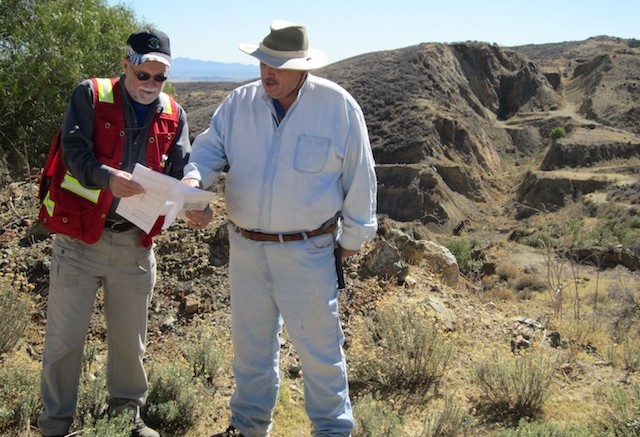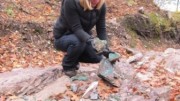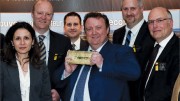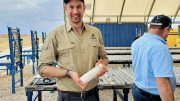ZACATECAS, MEXICO — Defiance Silver (TSXV: DEF; US-OTC: DNCVF) is determined to beat the odds and secure the funds it needs to bring the San Acacio project — containing the past-producing San Acacio silver mine and the Santa Gabriela mill — in Mexico into production.
The explorer is buying the 200-tonne-per-day Santa Gabriela mill from Impact Silver (TSXV: IPT) and a 100% interest in the historic mine from the Amado Mesta family.
Impact — Defiance’s largest shareholder with 15% — thought to combine the two assets but couldn’t cut a deal with the Mexican family who have owned the San Acacio mine since 1934, said Darrell Rader, Defiance’s director and Impact’s former manager of corporate development, during a site visit early this year.
Impact combed Zacatecas’ historic silver district in the early 2000s to find an operating base, Rader recalls. At that time, the claim maps in Zacatecas looked like a “jigsaw puzzle,” with hundreds of landowners and hardly any continuous land.
After canvassing the famed silver district, Impact signed an option to buy the Santa Gabriela mill in September 2006. The mill treated silver-lead-zinc ore from several mines in the district, including the San Acacio mine, on a custom-milling basis using flotation. Impact closed the mill in March 2010, right after buying it.
But before that, Impact studied where the mill feed was coming from. “We stationed a geologist at the toll mill and asked him to monitor all the feed being brought in the mill, and if he saw something interesting, to follow the guy back and try to do a deal on the project,” Rader recalls.
With that approach, Impact scooped up several small claims for $15,000 apiece, before coming across the feed from the San Acacio mine, 3 km away from the mill. San Acacio was one of Impact’s main targets because of its resource potential, but the company couldn’t get the Mesta family to sign on, Rader remarks.
Around this time, MAG Silver (TSX: MAG; NYSE-MKT: MVG) and Arian Silver (TSXV: AGQ; LSE: AGQ; US-OTC: ASLRF) — along with some other exploration companies — swooped into the district, and the prices for the small claims soared from $15,000 to $200,000, Rader says.
Consequently, Impact stopped pursuing the San Acacio mine because it became “too expensive.” This left the company with “less than critical mass in Zacatecas, and that is what created the opportunity for [Defiance] to get an option on San Acacio and marry the two assets,” Rader explains during a presentation before a tour of Defiance’s San Acacio project.
The property is located 6 km from the colonial city of Zacatecas in the state of Zacatecas. It is a kilometre off a paved highway and near the state power grid.
Rader and Impact’s founder and CEO Fred Davidson incorporated Defiance, formerly Defiance Capital, as a capital-pool company in July 2007 by issuing 2.6 million shares at 5¢ that were held in escrow. In May 2008, Defiance completed an initial public offering of 2 million shares for 10¢ apiece, resulting in 4.6 million shares outstanding. The firm has 23.9 million shares outstanding.
Defiance was created to explore gold targets in Nevada, but switched its focus to acquiring silver assets in Mexico. To reflect its new direction, the Vancouver-based outfit changed its name to Defiance Silver in June 2011.
That year the company picked up momentum. It made a two-year option agreement with Impact to buy a 100% interest in the Santa Gabriela mill, associated surface rights and 10 mining concessions in September 2011. In February 2012, Defiance paid Impact 2.7 million shares and in July 2013 extended the purchase agreement to September 2015. Under the revised terms, Defiance paid with 150,000 shares this year and will hand over $25,000, or 350,000 shares, in 2014. A final payment of $1.9 million is due in September 2015, or during commercial production.
“When we first did the deal with Impact they had the mill, but only 50,000 tonnes of dumps,” recalls Bruce Winfield, Defiance’s president and CEO, during the presentation. “So during my first four months or so as the president of Defiance, I was waking up at night and thinking: ‘This is not so good. We now have an option on our mill, but no feed.’”
Winfield convinced the Mesta family to option the San Acacio mine in late 2011. Upon signing the purchase agreement, Defiance paid US$75,000 for a 180-day due diligence period. Another US$200,000 was provided in 2012 upon entering a formal agreement, and in July that year, the company extended the option period to September 2015.
It will pay US$150,000 in four installments of US$37,500 from September 2013 to June 2014. It has additional payments of US$225,000 due in September 2014, and US$5.5 million in September 2015.
The contract also gives the vendor a 2.5% net smelter return royalty on production from the property, which Defiance can buy at any time for US$2.5 million.
The junior is securing funds to gain full ownership of its mill and mine on the San Acacio property. The property hosts much of the Veta Grande vein, one of the three main vein systems in the Zacatecas’ famous silver district.
The district started producing silver in 1546 and was Mexico’s largest historical producer, churning out 700 million oz. Today, Zacatecas is still Mexico’s largest silver producer and home to many producers, including Fresnillo (LSE: FRES; US-OTC: FNLPF), Goldcorp (TSX: G; NYSE: GG) and MAG Silver.
Winfield says the company’s crown jewel is the San Acacio mine, which covers 10 mining concessions, or 7.46 sq. km. The mine property covers 65% of the 8.5 km long Veta Grande vein, described as a “classical epithermal, silver-rich vein system, with accessory gold and base-metal credits.” Historically, only the richest oxide portions of Veta Grande and the accessory veins were mined, leaving the deeper sulphide mineralization largely untapped, Defiance says.
The deposit had been mined across a 1.5 km strike length and to an average depth of 200 metres, but some old workings reach 335 metres below surface, showing underground potential.
An estimated 80 million to 100 million oz. silver has been extracted from San Acacio, contributing to the more than 200 million oz. historically mined from the entire Veta Grande vein system, says Richard Tschauder, Defiance’s vice-president of exploration.
Mining came to a halt in the entire district around 1910 at the start of the Mexican Revolution, Winfield adds. From 1933 to 1935 the Grande Veta vein was split into two portions, with the Mesta family buying the area that controls the San Acacio mine.
In 1994, Silver Standard secured an option with Mesta to explore San Acacio. It ran a small drill program and outlined a historic resource before giving up its option in 1997. In 2004, around the same time Impact was pursuing the mine, Sterling Mining Co. entered a purchase agreement for San Acacio. Two years later, Source Exploration acquired that option from Sterling and completed drilling and a pre-scoping study. But in October 2010 it stopped operating at San Acacio to focus on another Mexican project.
In late 2011, Defiance got its hands on the San Acacio mine and updated the historic resource to National Instrument 43-101 standards in O
ctober 2012.
San Acacio has 3.55 million oz. silver from 1.15 million indicated tonnes grading 95.8 grams silver per tonne. It has another 12.45 million oz. silver from 2.89 million inferred tonnes of 134.1 grams silver per tonne.
“There’s a starter resource and it has got fantastic potential,” Winfield says. “It’s seldom in your career that you get to acquire an asset like that.”
A geologist by training, Winfield has spent over 35 years holding senior management positions with mining companies large and small. At one point, he worked as the vice-president of exploration for Greenstone Resources and later Eldorado Gold (TSX: ELD; NYSE: EGO). At Greenstone, he helped acquire and explore four deposits that later became producing mines, including the La Libertad gold mine in Nicaragua.
He points out that, over their careers, Defiance Silver’s current management team have discovered or acquired 12 projects that have been brought into production, and he hopes that San Acacio will become lucky number 13.
While San Acacio’s initial resource estimate was calculated for an open-pit mine using large waste blocks, Winfield says that the silver grade should increase once the company recalculates the resource for an underground deposit. “We’d probably have 1 million ounces less, but the grade will be around 175 grams per tonne,” he reckons. The San Acacio property also holds 4 km of vein strike that has not seen modern exploration, he adds.
Once the company secures more capital it plans to update the resource and explore the vein strike, among other things. In its most recent efforts to raise money, the junior signed a share-exchange agreement with Global Resource Investments, agreeing to issue Global 5.1 million of its shares. In exchange, Global — which intends to re-register as a public firm on the London Stock Exchange under the name Global Resources Investment Trust (GRIT) — will provide Defiance 311,610 of its shares at a deemed value of £1 apiece. Afterwards, Defiance would sell the GRIT shares to raise funds. Defiance notes the transaction requires regulatory approvals and GRIT to list on the London Stock Exchange. If the deal closes, Defiance’s shares outstanding would increase from 23.9 million to 29 million. Global would own 17.6% of the junior.
In late July, Defiance raised $215,000 by closing the first tranche of a previously announced $500,000 private placement. It sold 2.15 million units at 10¢. Each unit consists of one share and half a warrant, with a whole warrant exercisable at 15¢ during the first year and at 20¢ in the second year.
The company says the proceeds from the financings will also go towards care and maintenance at the Santa Gabriela mill, metallurgical tests, permitting, geophysics and general and administrative expenses.
Defiance is leaning towards bringing the mine and mill online as a 200- to 500-tonne-per-day operation, before expanding to 1,000 tonnes per day. The initial start-up date will depend on the company’s access to capital.
“We are doing this in a low-risk fashion. We are learning to walk before we run,” Winfield says. “And it works well.”
The company’s shares closed Oct. 7 at 6¢, within a 52-week trading range of 5¢ to 30¢. Defiance Silver has a $1.5-million market capitalization.






Be the first to comment on "Defiance Silver takes steady steps at San Acacio"